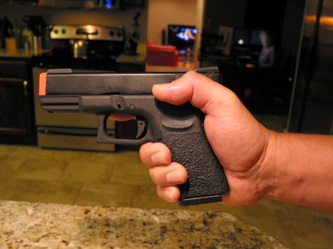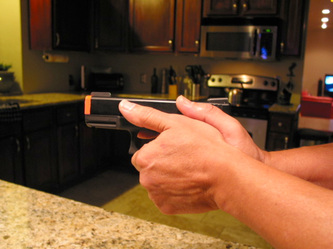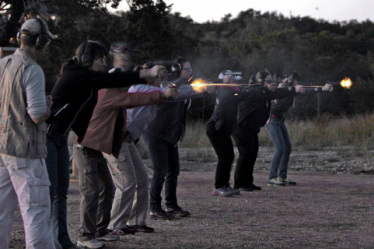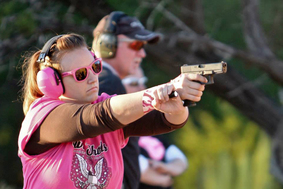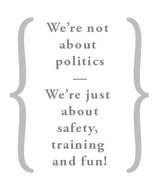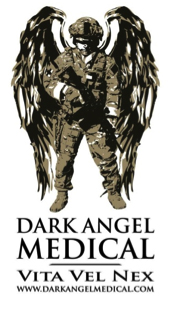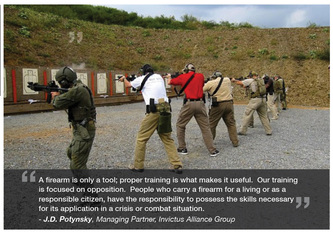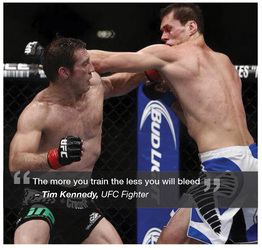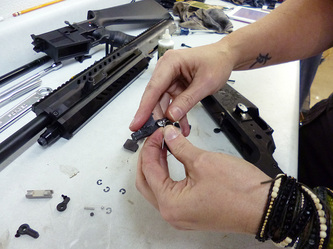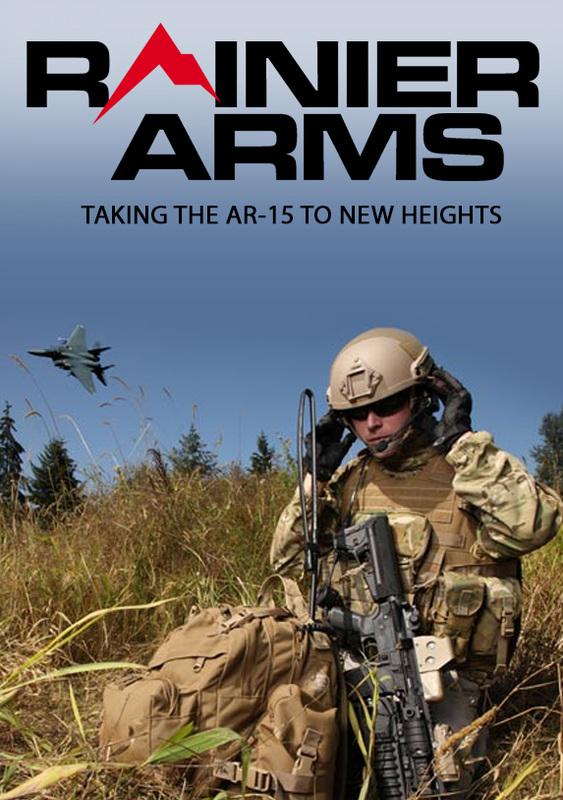ARCHIVE - ISSUE FIVE- NOV 2013 FEATURE PICTORIAL - COVER - LIFESTYLE - REVIEWS ARCHIVE - ISSUE FIVE - NOV 2013
GET A GRIP! by Bill Ferris Gripping Your Pistol: How Many Ways Are There? Answer – only one! One thing I’ve learned in all my years of shooting at a competitive level and with the best pistol shooters in the world is that there is only one way to grip a semi-automatic pistol correctly. I’m going to try to explain what I feel is the proper grip for fast, accurate and controllable shooting. If you can get this right at the beginning, it will save you years of shooting. First, the strong hand. While holding the pistol in your weak hand, spread the fingers of your strong hand as wide as possible, then take the webbing between your thumb and index finger and place it as high on the back of the pistol as possible as in Fig. 1. The first goal is to get your grip as high as is allowed before the slide starts taking skin off of your webbing. As you start to grip the pistol, you will wrap your remaining three fingers around the front of the pistol, under the trigger guard, and should be able to actually support the gun comfortably with just your strong hand as shown in Fig. 2. Many people use the thumb as part of the grip, which then brings the index or trigger finger into play. Your thumb and index finger should both be free to move. Second, the weak hand. Take your weak hand and point your thumb forward, as you wrap your fingers around and on top of the three fingers which currently hold the pistol. When pointing your weak hand thumb in the same direction as your strong hand thumb, it makes a contour on the back of your weak hand that matches the contour underneath your strong hand thumb as shown in Fig. 3.
Figure 4 shows your hands coming together like two pieces of a puzzle. You can almost feel your hands click into each other when this is done correctly. The end result is both of your palms supporting the pistol with your thumbs pointing downrange at your target with your arms and torso forming a natural isosceles triangle. This is the best way to shoot quickly, accurately, while moving or static from just about any shooting position. Don’t believe me? YouTube any of the top shooters and see for yourself. Good shooting! Bill Ferris is a USPSA/IPSC Master Class competitive shooter, also competing in IDPA, NRA "F" class 1000yd Rifle, Two Gun, Three Gun and Steel Challenge competitions. In addition to his extensive shooting experience, Bill is a Certified NRA Instructor for Basic Pistol, Home Firearm Safety, and Personal Protection plus does custom gunsmithing. He is currently registered by the Texas Department of Public Safety, Private Security Bureau as a Personal Protection Officer, Private Investigator and Commissioned Security Officer. Doin' it in the Dark
|
5 Days of Hardcore Defensive Training Sure Shot Mandy representing strong in Orlando! Sure Shot Mandy representing strong in Orlando!
by Mandy Creager
The Women’s Defensive Training Experience, hosted by the ASC Shooting Academy, was held this year from October 18-23 in Orlando, FL. It is a 5-day women’s only training that involves defensive pistol and shotgun, unarmed defense as well as laser and electronic simulators. This was the 3rd annual WDTE. Zane Plumley, Chief Instructor at ASC Shooting Academy, has organized with an average of 24 women in attendance each year. However, 2013 presented some challenges that nearly derailed this year’s event - ammo shortages and low attendance being the biggest.  Loren, Mandy and Monica kicking ass on MILES. Loren, Mandy and Monica kicking ass on MILES.
Plumley was inspired to create the WDTE after he was an instructor at the 2010 NRA’s Women’s Wilderness Escape. He said so many women left the event wanting more, especially in terms of self-defense training. Enough women contacted him after the WWE that it convinced Plumley to offer them an opportunity to better themselves through training on military based equipment.
I was invited to attend this year’s WDTE by fellow Sure Shot and past WDTE graduate, Loren Rice. We had the pleasure of joining fellow Sure Shot Monica Hernandez on the adventure. Even though the event was scaled back from previous years, I thoroughly enjoyed myself and walked away from the WDTE with some valuable knowledge and skills. Logistically speaking, the WDTE schedule is a full, five 9.5 hour days with an additional two-hour optional activities each night. It was tough physically and mentally but I was having so much fun the hours flew by. A good night’s sleep was enough to renew me each day (not so much for my sore muscles though.) The women are divided into teams the first day and spend the rest of their time in those teams (minus the communal breakfast and lunches provided by ASC). Each day was broken into two training sessions. Outdoor activities like the MILES (Multiple Integrated Laser Engagement System) were usually held in the mornings with an afternoon on the indoor live-fire range or in the dimly lit electronic simulator room. The optional activities each evening practically begged you to come back. One night they covered low-light shooting and flashlight techniques, another time it was a discussion on bug-out bags while another night included the ever popular zombie-shoot on the live-fire range. Clearly, the highlights of the WDTE are working with military and law enforcement training systems like the electronic simulator and the MILES gear. MILES is basically a very realistic laser tag game in which opposing teams suit up in vest and helmets that have embedded laser sensors and are synced with corresponding ARs loaded with .556 caliber blanks. Participants are taken to an alley of an empty storage facility (on campus) and are supposed to hone their skills in taking cover/concealment and tactically advancing into “enemy” territory using the provided barricades, sniper tower, guard post and stacked pallets. You and your teammates learn strategy, team management and, in my case, how to manage major adrenaline spikes in my body. "There are very few times in my life, if any at all, where I can recall having to work in such high stress situations while maintaining my wits - much more importantly, the muzzle of a gun." 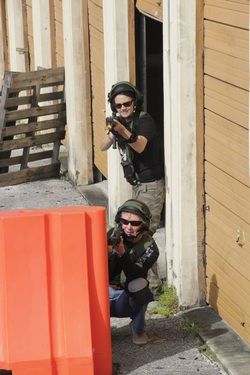
MILES gear was also donned during epic shoot-house trainings where teams are divided into “good guy/bad guy” scenarios inside a simulated house. Participants learn ways to properly clear a house and good/bad defensible positions while using their environment.
The other fun and non-traditional training aspect that WDTE provided was the electronic simulator. Real firearms are modified and hooked up to what amounts to an XBOX for law enforcement training. We used Beretta 9mm during training days and modified AR’s for competition day - each weapon requiring regular manipulation and magazine changes . The simulator system provides a vast variety of target practice including silhouettes at varying distances, moving targets, plate-rack competitions, friend/foe targets, speed drills, law enforcement scenarios, and desert or urban combat simulations. Man, this thing was cool. While it sure was fun, the educational function of the simulator can show the shooter where their muzzle was pointed both 2 seconds before a shot was fired and 2 seconds after which helps one to troubleshoot any problems they might be having. At the touch of a button, the instructor can change up the challenges and review the shooters statistics, making this one game you can play all day long! While simulators are inexpensive target practice and fun for everyone, nothing is quite as exhilarating as live-fire. ASC uses frangible, lead-free ammunition on their indoor, air-conditioned range and has fully automated and programmable target pulleys. We worked with Smith and Wesson .22 AR’s doing drills at 25 yards in varying positions one afternoon. During another session we did some defensive pistol drills with their Glock 17 9mms from varying distances, practiced drawing and shooting from the hip and shooting from behind cover. Most enjoyable for me was the day we used 12 gauge pump-action shotguns loaded with slugs. It was fun because it was something that many of us women were intimidated by initially but soon conquered and excelled in. As with the previous weapons, we did close range target drills as well as shooting from behind cover. Closing day of the WDTE pitted team on team on the MILES alley way course as well as individual competitions on both the electronic simulator and the live-fire range. The simulator competition featured a desert combat scenario where the shooter has a set amount of time to pick off moving targets from varying distances. Once completed you were scored on how many shots were fired, how many hits, how many fatal hits and given a hit to shots fired ratio. On the live-fire range, the instructor ran individuals through a timed mini 3-gun competition - 3 rounds from the aforementioned S&W ARs at 20 yards, 2 rounds from the 12-gauge pump action shotguns at 10 yards and then 5 rounds from the Glock 17 9mms at 7 yards. Awards for team and individual performances were given out at a banquet that evening.  Monica's got this handled. Monica's got this handled.
Sprinkled in between electronic, laser and live-firing drills was practicing unarmed defense techniques. To be honest, it was something I had never personally sought training in and therefore I was a bit unnerved doing it on our first day. We learned about defensive mindset and how to react to a pistol to the head from behind, pistol to the head from the front, knife to the throat from the front and how to (hopefully) successfully disarm the attacker. It was fun and scary all rolled into one but I learned enough to want to come home and seek more training in this arena.
One appreciated and often underestimated aspect of training was the quality and approach of the instructors. Yes, they were all men but they were men who had a certain knack for working with women of all ages. If I were to guess, I’d say the average age of the women participating in the WDTE was about 60 years old but we had everyone from the young, experienced and spunky, first timers who’ve only fired a gun twice, and women who were previous instructors at the NRA’s Women’s Wilderness Retreat. These guys knew how to deliver their message with just the right amount of sensitivity, candor and patience. They kept us laughing and asking questions all week long and genuinely seemed to love what they were doing and enjoyed working with these ladies. “Women are easier to teach,” Plumley said. “They come into the event ready to learn. They don't bring arrogance to the table that they already know how to do something and completely disregard the instruction given to them. Women also like to ask questions, and this always helps the Instructor tailor the program as a group and to individuals.” Succinctly put, the WDTE left me with new skills to add to my “toolkit of badassery” and a desire to keep wanting more. True, there were aspects that could be improved upon but I had to remember that this year was a scaled back version of previous years. I had a great time leaving my normal life behind for a week and challenging myself to push my limits of adrenaline and test my skills. More importantly, I enjoyed the experience I shared with my fellow Sure Shots Loren and Monica. It was such fun to take my relationship with these girls “off the practice range” and get to know them better as shooters and as friends. It was also great to expand my network and get to know other fiery women from around the country who share in my love for firearms, defense and the sport of shooting. Dates for the 2014 WDTE are expected to be announced in December 2013. For more information about WDTE, search for Women’s Defensive Training Experience on Facebook or go to www.ascshootingacademy.com. |

